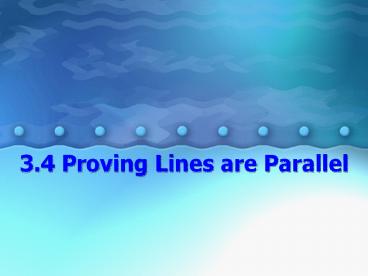3.4 Proving Lines are Parallel - PowerPoint PPT Presentation
Title:
3.4 Proving Lines are Parallel
Description:
Objectives/Assignment Prove that two lines are parallel. Use properties of parallel lines to solve real-life problems Assignment: 2-28 even, 32-35 all Postulate 16 ... – PowerPoint PPT presentation
Number of Views:215
Avg rating:3.0/5.0
Title: 3.4 Proving Lines are Parallel
1
3.4 Proving Lines are Parallel
2
Postulate 16 Corresponding Angles Converse (pg
143 for normal postulate 15)
Goal 1 Proving Lines are Parallel
- If two lines are cut by a transversal so that
corresponding angles are congruent, then the
lines are parallel.
j
k
j ll k
3
Theorem 3.8 Alternate Interior Angles Converse
(pg 143 Theorem 3.4)
- If two lines are cut by a transversal so that
alternate interior angles are congruent, then the
lines are parallel.
j
3
1
k
4
Theorem 3.9 Consecutive Interior Angles
Converse (pg 143 Theorem 3.5)
- If two lines are cut by a transversal so that
consecutive interior angles are supplementary,
then the lines are parallel.
j
2
1
k
5
Theorem 3.10 Alternate Exterior Angles Converse
(pg 143 Theorem 3.6)
- If two lines are cut by a transversal so that
alternate exterior angles are congruent, then the
lines are parallel.
4
j
k
5
6
Prove the Alternate Interior Angles Converse
- Given ?1 ? ?2
- Prove m n
3
m
2
1
n
7
Example 1 Proof of Alternate Interior Converse
- Statements
- ?1 ? ?2
- ?2 ? ?3
- ?1 ? ?3
- m n
- Reasons
- Given
- Vertical Angles
- Transitive prop.
- Corresponding angles converse
Given ?1 ? ?2 Prove m n
3
m
2
1
n
8
Example 2 Proof of the Consecutive Interior
Angles Converse
- Given ?4 and ?5 are supplementary
- Prove g h
g
6
5
4
h
9
Paragraph Proof
- You are given that ?4 and ?5 are supplementary.
By the Linear Pair Postulate, ?5 and ?6 are also
supplementary because they form a linear pair.
By the Congruent Supplements Theorem, it follows
that ?4 ? ?6. Therefore, by the Alternate
Interior Angles Converse, g and h are parallel.
g
6
5
Given ?4 and ?5 are supplementary Prove g h
4
h
10
Find the value of x that makes j k.
Example 3 Applying the Consecutive Interior
Angles Converse
- Solution
- Lines j and k will be parallel if the marked
angles are supplementary. - x? 4x? 180 ?
- 5x 180 ?
- X 36 ?
- 4x 144 ?
- So, if x 36, then j k
4x?
x?
11
Goal 2 Using Parallel ConversesExample 4
Using CorrespondingAngles Converse
- SAILING - If two boats sail at a 45? angle to
the wind as shown, and the wind is constant, will
their paths ever cross? Explain
12
Solution
- Because corresponding angles are congruent,
the boats paths are parallel. Parallel lines do
not intersect, so the boats paths will not cross.
13
Example 5 Identifying parallel lines
- Decide which rays are parallel.
H
E
G
61?
58?
62?
59?
C
A
B
D
A. Is EB parallel to HD? B. Is EA parallel to
HC?
14
Example 5 Identifying parallel lines (cont.)
- Decide which rays are parallel.
H
E
G
61?
58?
B
D
- Is EB parallel to HD?
- m?BEH 58? m ?DHG 61?
- The angles are corresponding, but not
congruent, so EB and HD are not parallel.
15
Example 5 Identifying parallel lines (cont.)
- Decide which rays are parallel.
H
E
G
120?
120?
C
A
B. Is EA parallel to HC? m ?AEH 62? 58? m
?CHG 59? 61? ?AEH and ?CHG are congruent
corresponding angles, so EA HC
16
Conclusion
- Two lines are cut by a transversal. How can
you prove the lines are parallel? - Show that either a pair of alternate interior
angles, or a pair of corresponding angles, or a
pair of alternate exterior angles is congruent,
or show that a pair of consecutive interior
angles is supplementary.































